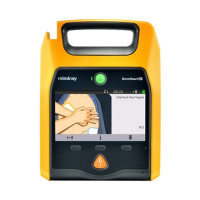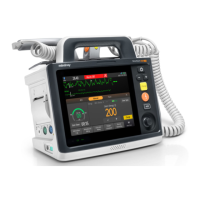Defibrillator/Monitor Operator’s Manual 14 - 1
14 Monitoring CO
2
14.1 CO
2
Introduction
CO
2
monitoring is a continuous, non-invasive technique for determining the concentration of CO
2
in the
patient’s airway by measuring the absorption of infrared (IR) light of specific wavelengths. The CO
2
has its own
absorption characteristic and the amount of light passing the gas probe depends on the concentration of the
measured CO
2
. When a specific band of IR light is passed through respiratory gas samples, some of IR light will
be absorbed by the CO
2
molecules. The amount of IR light transmitted after it has been passed through the
respiratory gas sample is measured with a photodetector. From the amount of IR light measured, the
concentration of CO
2
is calculated.
CO
2
monitoring is intended for adult, pediatric and neonatal patients.
14.2 CO
2
Safety Information
• Remove the airway sampling line from the patient’s airway while nebulized medications are being
delivered.
• Leakage in the breathing or sampling system may cause the displayed EtCO
2
values to be
significantly low. Always make sure that all components are securely connected.
• EtCO
2
values measured from the CO
2
module may differ from those of from the blood gas analysis.
• Route all tubing away from the patient’s throat to avoid strangulation.
• Inspect the airway adapter for a tight connection and proper operation before attaching it to the
patient.
• Squeezing or bending the sampling line during the CO
2
measurement may cause inaccurate CO
2
reading or no reading.
14.3 CO
2
Measurement Limitations
The following factors may influence the accuracy of measurement:
■ Leakage or internal venting of sampled gas
■ Mechanical shock
■ Cyclic pressure higher than 10 kPa (100 cmH
2
O) or abnormal change to airway pressure
■ Other sources of interference, if any.
Measurement accuracy of the CO
2
m
odule may be affected by the breath rate and inspiration/expiration (I/E)
ratio. For details, refer to A.5.7CO
2
Specifications.

